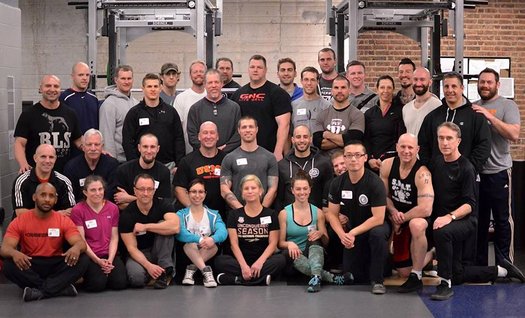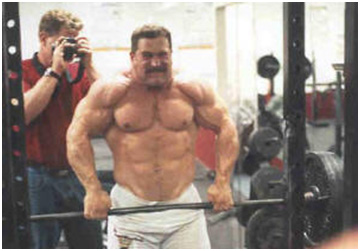
If you can imagine a conference that assembled the best minds in a particular field (think science, economics, theology, etc.) and turned them loose on the subject it would be considered a “think tank”. Now imagine getting world class coaches and internationally ranked strength athletes together in a gym for two days of nothing but teaching, talking and sharing secrets about how to get inhumanly strong; it would be considered an “M1 Abrams Tank”! That’s exactly what happened on March 8th and 9th at the George A Weiss Pavilion on the University of Pennsylvania when RKCs, athletes, coaches and weightlifting enthusiasts from the United States and Canada gathered to learn from Marty Gallagher at his Purposefully Primitive Strength Training Seminar (PPS).
OVERVIEW
The first PPS really was an amazing event that brought one of the most successful strength coaches in the world (Marty Gallagher) together with some of the top athletes and mentors in the strength arena including Kirk Karwoski, Brad Gillingham, Chuck Miller, and Dr. Michael Davis–a veritable “Dream Team of Iron and Steel”. The event would have been worth it just to have Marty lecture and teach the fundamentals, but the inclusion of Kirk, Brad, Chuck, and Dr. Michael made the event impossible to miss and incredible to attend. For anyone that is interested in learning from men who have “been there, done that, and got the t-shirt” this was a unique opportunity to listen to and learn from the best of the best in the iron game.
DAY ONE
The first day of the PPS was dedicated to squatting. A whole day to squats you say? Yes – and it was worth every minute we devoted to the subject. We covered basic variations, progressions, and regressions of the squat and how to get as strong as possible while training as safely as possible. Still seems like a lot of time to devote to one lift, but the amount of detail covered literally took the whole day. As a matter of fact I think we could have devoted another day to the subject!
DAY TWO
The second day of the PPS was devoted to the bench press, deadlift, and overhead press. This was a lot to cover on the second day, but with the baseline set for prepping and initiating movement on day one, we were able to get through it. Once again the various lifts were broken down into palatable pieces we worked through then tested under load with the watchful eye of the training staff. Errors in loading, positioning, tempo, etc. were identified, corrected, and made before the lift was re-tested. Think about this: if you had the man with a world-record-setting deadlift giving you pointers and corrections on your technique, do you think you’d be able to make improvements? How about working with the man who has the best squat in the world? It was an incredible experience to say the least.
HIGHLIGHTS & QUOTES
There were a huge number of highlights and quotes from both days of the seminar. On just the first day during the morning session, I took five pages of notes. Marty has an encyclopedic knowledge of the subject and several lifetimes of experience in lifting and developing other lifters. He also did a great job at integrating the instructor team into each subject and drew out their comments, critiques and training stories. The combination of lecture, demonstration and hands-on application worked like a charm. Having some of the strongest men in the world help tighten up your technique was beyond amazing.
Several highlights from both days:
- Listening and watching Kirk prepare for his bench press. It was impressive to see this process and ritual up close.
- Watching Brad get into position for his deadlift. Just the process of “wedging” himself under the bar caused hundreds of pounds to levitate prior to him actually executing the lift.
- Seeing Dr. Mike bench press a pair of 130 pound dumbbells like they were 30 pound dumbbells.
Several quotes from both days from various instructors:
- “Absolute strength is the goal…”
- “Make light weights heavy…”
- “Success is achieved through a narrow menu and proven tactics…”
- “There is no athletic endeavor that can be developed in less time than strength…”
- “Resistance training changes from intellectual to emotional as load increases…”
- “In strength training, patience is not a virtue it’s a necessity…”
One of the most impressive ideas was a different approach to the execution of the deadlift. As an RKC, I was taught that the deadlift is primarily a hinge movement. But Marty and the teaching cadre at the PPS showed us that the deadlift is more of a squat with a hinge completion. This is highly evident if you look at how these strong men set up their deadlift compared to an RKC style deadlift. The primary difference is that the angle of the shin and torso are nearly parallel or lined up to each other. Both are very tall and upright, then the deadlift is initiated by a forceful explosion of the legs which drives the ground away and pulls the bar to the knees where the move is finally completed with a hinge of the hips. While this concept is not all that different, the execution of it is startlingly effective and will allow you to lift a lot more weight. Also among the five legendary instructors, all use a conventional narrow stance with toes slightly out.
Another item of general consensus among these men is to work on your front squat if you want your deadlifting ability to increase. If you’ve hit a plateau with your deadlift, then work on your squat and the numbers will follow—this is due to the squat style initiation of the deadlift as mentioned above.
WRAP-UP
I can’t say enough good “stuff” about the PPS. It was a great training experience and I came away with a new appreciation for the sport of Powerlifting and the application of absolute strength in any training program. The teaching was stellar, the location (University of Pennsylvania) was spectacular, and the attendees were all amazing… seriously!
If you get a chance to attend the PPS I would strongly suggest that you do it. You will learn so much more than you can imagine about the core lifts as well as come away with knowledge from the absolute best (and strongest) in the world. You cannot match this experience anywhere and I challenge you to not come away absolutely stoked to start tossing around heavy things!
For those of you that attended the seminar you were treated to a truly awesome experience! This first time through was like “lightning in a bottle” and the information and training was electric as was the atmosphere. I don’t think a single attendee didn’t get a personal record on any of the lifts they attempted, and most of them had been lifting for quite a while. When you are in a position to learn from the best and strongest in the world their enthusiasm and passion for lifting is infectious and great things happen.
The PPS focus on absolute strength is a great addition to our skills as RKC instructors. The benefit of developing absolute strength can only benefit our strength endurance and help to improve our kettlebell technique
REFERENCES
- Marty Gallagher – learn more about Marty Gallagher and his book Purposeful Primitive, by visiting the Dragon Door website.
- Brad Gillingham – learn more about Brad Gillingham by checking out his bio on the Jackal’s Gym website.
- Kirk Karwoski – learn more about “Captain Kirk” Karwoski by checking his page on the Wikipedia website.
- Dr. Mike Davis – learn more about Dr. Mike Davis by going to his blog.
- Chuck Miller – learn more about Chuck Miller on the Strength and Health Alliance website.
***
About Michael A. Krivka, Sr. – Senior RKC: Michael A. Krivka, Sr. is a Washington, DC native who has been involved in Kettlebell training for over a decade and is currently an RKC Team Leader and member of the RKC Board of Advisors and the RKC Leadership Team under Dragon Door (where he has been listed as one of the top reviewed RKC’s in the world for the last five years). He is also the author of a bestselling eBook entitled “Code Name: Indestructible” and is in the process of finishing up several other eBooks on Kettlebells, body weight, and the integration of other tools into an effective strength and conditioning program. Mike has traveled extensively throughout the United States teaching Russian Kettlebells to military (USMC, USN, USA and USAF) and law enforcement personnel (FBI, DEA, USSS and CIA) as well hard-living civilians from Soccer Moms to CEOs. In addition to teaching workshops and clinics he logs several hundred hours a year teaching and training with Russian Kettlebells at his own gym and martial arts studio. He is also a Level I CrossFit Trainer, and Olympic Lifting Coach..
